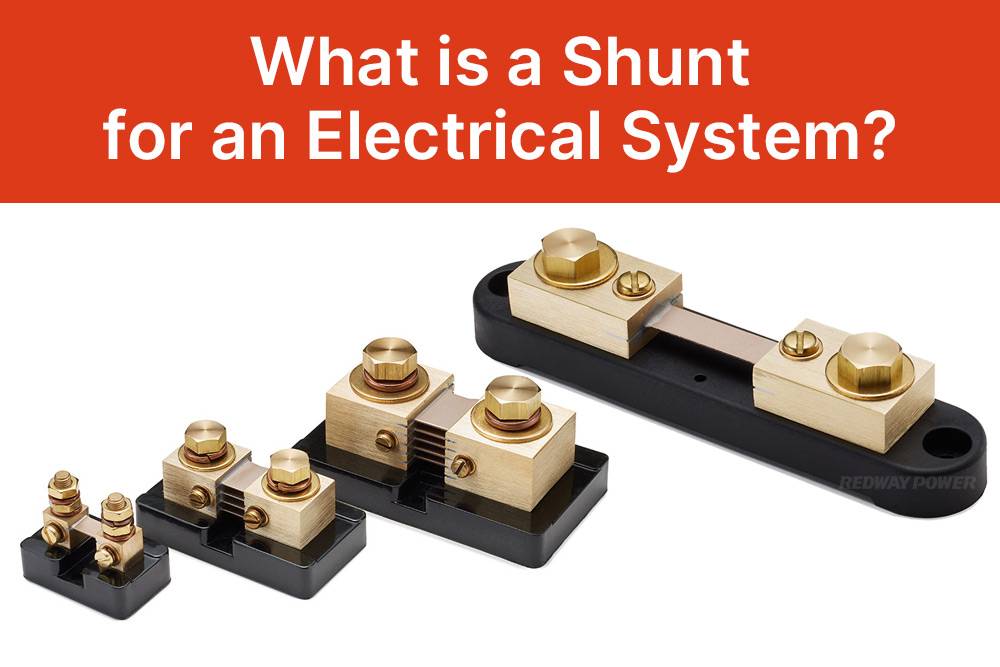
Blog
What Is a Shunt for an Electrical System?

A shunt in an electrical system is a precise, low-resistance component that creates an alternative path for electrical current to flow, enabling accurate current measurement and circuit protection. It diverts most of the current around sensitive devices, allowing monitoring instruments—like ammeters or battery monitors—to safely measure high currents by detecting a small voltage drop across the shunt.
What Is a Shunt in an Electrical System?
A shunt is a specialized low-resistance resistor installed in an electrical circuit to permit current to bypass a particular section. Its main role is to generate a small, measurable voltage drop proportional to the current flowing through it. This voltage is then used to calculate the exact current without interrupting or overloading the main circuit.
How Does a Shunt Work to Measure Electrical Current?
When current flows through the shunt, due to its known very low resistance, a tiny voltage drop is created across its terminals based on Ohm’s Law (V = I × R). This small voltage drop is safe and measurable by monitoring devices. By knowing the shunt’s resistance, the current can be precisely calculated from the measured voltage, enabling real-time current monitoring of high-power systems.
Which Applications Commonly Use Electrical Shunts?
Electrical shunts are commonly used in battery monitoring systems, industrial power management, renewable energy (solar and wind), electric vehicles, and medical devices. They measure current flow in circuits to monitor battery health, control overcurrent protection, and enhance system efficiency and safety.
Why Are Shunts Important for Battery and Power System Monitoring?
In battery-powered systems such as those made or serviced by Redway Power, shunts are critical for accurately measuring current draw and charge flow. They provide essential data to battery management systems that optimize charging, prevent over-discharge, and extend battery life, ensuring reliable and safe operation of forklifts, golf carts, marine, and other electric equipment.
How Is a Shunt Installed in an Electrical Circuit?
Shunts are typically placed in series with the negative terminal (common ground) side of the circuit or battery system. This placement protects measurement instruments from high voltages while allowing the full current to flow through the shunt. Proper installation involves securely mounting the shunt and connecting it directly to a monitoring device to measure the voltage drop.
Can Shunts Protect Electrical Systems from Overcurrent?
While primarily used for current measurement, shunts can indirectly aid in overcurrent protection by providing real-time current data to control systems. These systems trigger alarms, disconnect loads, or reduce current flow when excessive currents are detected, thus preventing damage to components or batteries.
What Materials and Characteristics Define a High-Quality Shunt?
High-quality shunts are made from materials with stable, low temperature coefficients of resistance, such as manganin or constantan alloys. This stability ensures the resistance remains constant despite temperature changes, maintaining measurement accuracy and reliability over the shunt’s lifespan.
Electrical Shunt Key Characteristics Chart
| Property | Typical Value/Material | Importance |
|---|---|---|
| Resistance | Very Low (milliohms) | Minimizes voltage drop and power loss |
| Material | Manganin, Constantan | Stability over temperature changes |
| Accuracy | ±0.1% to ±1% | Precise current measurement |
| Power Rating | Varies (e.g., 1W to 100W) | Handles expected current loads |
| Installation Point | Negative battery terminal or circuit ground | Safe and effective measurement placement |
How Does Redway Power Integrate Shunts in Their Battery Systems?
Redway Power, with over 13 years of OEM experience in lithium battery pack manufacturing, incorporates precision shunts within their battery monitoring systems to deliver accurate current measurement for forklifts, golf carts, marine, and telecom applications. Their MES (Manufacturing Execution System) ensures each system’s components, including shunts, meet stringent quality and consistency standards.
When Should You Consider Using a Shunt in Your Electrical System?
Use a shunt when accurate and continuous current measurement is required, especially for battery management, power distribution monitoring, or where overcurrent detection is critical. Shunts are essential in systems aiming to maximize safety, efficiency, and battery longevity, such as industrial equipment powered by Redway Power lithium battery packs.
How Do Shunts Differ from Other Current Measuring Devices?
Unlike clamp meters or Hall-effect sensors that measure magnetic fields generated by current, shunts measure actual voltage drop caused by current through a low-resistance path. This direct electrical measurement is highly accurate and preferred in fixed system monitoring where precise current values are critical.
Redway Power Expert Views
“In electrical systems, a shunt acts as the sentinel for current flow, providing precise measurements that empower battery management systems to deliver safe, efficient, and reliable power. At Redway Power, integrating high-precision shunts within our lithium battery packs exemplifies our commitment to quality and performance, ensuring optimal operation in forklifts, golf carts, and marine applications worldwide.”
— Chief Engineer, Redway Power
Conclusion
A shunt is a fundamental component in modern electrical systems, serving as a precise low-resistance path to measure current safely and accurately. Its integration is vital for battery monitoring, overcurrent protection, and maintaining system health—especially in applications such as those supported by Redway Power’s OEM lithium battery solutions. Proper use and installation of shunts enhance safety, efficiency, and longevity in complex electrical systems.
FAQs
Q: What is the primary function of a shunt in an electrical circuit?
A: To provide a low-resistance path enabling accurate current measurement by creating a measurable voltage drop.
Q: Where is a shunt typically installed?
A: Usually in series on the negative terminal or ground side of the battery or circuit for safety and accuracy.
Q: How does a shunt measure high current safely?
A: By allowing most current to bypass the measuring instrument and producing a small, proportional voltage drop for measurement.
Q: Can shunts be used for overcurrent protection?
A: Indirectly, as they provide current data that control systems use to detect and respond to overcurrent conditions.
Q: Why are materials like manganin used for shunts?
A: Because they offer stable, low-resistance values with minimal variation due to temperature, ensuring accuracy.



